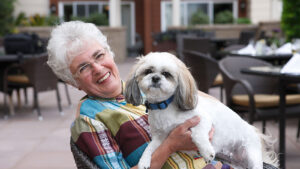As we hit our 50s, most of us are finding it more difficult to read without glasses. We likely wear bifocals, and the changes to our vision can become subtle. Unfortunately, as our vision decreases, our risk of falling increases. While most of us will not suffer from complete blindness, millions currently live with some form of visual impairment, and because it’s so gradual we may not even realize that our vision is impaired.
According to the National Eye Institute (NEI), older adults represent the majority of the visually impaired population in the United States. This is caused either by disease, (glaucoma, cataracts, macular degeneration, retinopathy) or it can also become affected by medications or dizziness.
While vision loss later in life is common, it can be particularly difficult for seniors to accept. Night driving may become an issue, and their ability to adapt to as other senses like hearing, smell and taste also tend to weaken with age. You may find them resistant to getting checked out more regularly by their eye doctor.
Keeping an Eye on Visual Health
The American Academy of Ophthalmology recommends individuals age 65 and older get a dilated medical eye exam every year or two, or as recommended by their ophthalmologist. During a routine eye exam, the ophthalmologist will evaluate a patient’s eyesight and assess the overall health and function of both eyes. Screening for new or worsening eye conditions and maintaining a current prescription for eyeglasses and/or contacts are crucial for optimal visual function at any age.
For most people, vision loss happens so slowly. We may not realize how much vision we have lost and seniors (and their family members) may not be aware of how compromised their eyesight has become. Because the changes are so subtle Caregivers can help keep tabs on a loved one’s vision by looking for an increase in:
- Squinting or tilting their head when trying to focus.
- Bumping into things or knocking objects over.
- Discontinuing everyday vision-based activities like reading or writing.
- Missing objects when reaching for them.
- Falling or walking hesitantly.
If a loved one is still driving, an increase in accidents and risky maneuvers may also indicate visual changes. It is important to discuss these noticeable changes with your loved one and make an eye appointment to ensure early detection and treatment of any eye diseases and prevent lasting damage.
Helping a Loved One Accept Visual Changes
Eye diseases like macular degeneration, cataracts, glaucoma and diabetic retinopathy can have a significant impact on a senior’s functional abilities and quality of life. For some, impaired vision may even result in depression, withdrawal and inactivity.
“Many older adults believe that there is no way they can cope with this loss, since it affects almost all aspects of daily life,” Rogers explains. “But, caregivers and persons with visual impairment need to know that there is hope, and life, after vision loss.”
Take the time to talk to your loved one about their fears or changes that can help them.
Tips and Products for Helping a Senior with Low Vision
It is best for family members to learn as much as possible about their senior loved one’s visual condition and their visual limitations. This information will help you suggest appropriate modifications to their environment and behavior as well as products that can enhance their functional abilities.
While individual conditions affect eyesight differently, the following tips are an excellent starting point for helping a blind or visually impaired senior safely maintain their independence.
Good Lighting is Key
Keep surroundings well-lit but be mindful of glare. Use specialized lamps/bulbs to increase contrast and reduce glare and cover reflective surfaces when possible. Ensure that appropriate lighting is provided for all activities your loved one engages in. For example, direct task lighting is best for things like reading, playing cards or crafting. Consider a small gooseneck or clip-on lamp for these tasks. Under-counter lighting is another type that works well for illuminating the kitchen and other larger work areas.
There are also some great motion detector sensors on the market that can turn on a lamp as soon as you enter a room. They can help light a path in the middle of the night, or outdoors on a sidewalk.
Room Lighting
You may think that putting a large bright light into a dark room can help. Actually it can do more harm than good, as it casts shadows and doesn’t provide the right type of lighting to navigate the home. Instead, it’s important to increase task lighting. Even during daylight hours, having a task light near a chair is important.
Use nightlights in bedrooms, hallways and bathrooms to reduce the risk of tripping and falling at night. One of the best products I have seen is a motion detector light that mounts to a nightstand and as soon as a senior’s feet hit the floor to sit up in bed, it triggers the light. It will stay on for a pre-designated period of time, to light the path of a senior who needs to get up in the middle of the night.
Improve Household Organization
If your loved one has been living in their home for over 20 years, I can almost bet that there are items in the home that are there but are never used anymore. Stuff creates clutter. Clutter creates falls!
Eliminate clutter and remove hazards such as throw rugs and tie up electrical cords. Consider replacing or relocating short or difficult to see furniture, such as a glass coffee or side table. Create wide, clear and level walking paths that lead to all areas of the home for easy and safe navigation.
You may have to reposition some furnishings to make the home easier to navigate. This can be disorienting initially, so make sure to provide your loved one with extra assistance getting around until they have memorized the new layout. Larger-scale rearrangements may be inadvisable for some seniors, especially those with memory issues.
Make sure that the floor is even, and if the carpet is too high pile, replace it with a lower pile carpet. If your loved one needs a cane or a walker, a laminate or hardwood floor is even better. Pay attention to door thresholds and steps. Make sure that any step in the house has a railing, even if it is just a couple of steps!
Storage solutions for commonly used items is key. There is likely a specific chair or place that your loved one sits in their home. Around them will likely be reading glasses, a tv remote, a cell phone, charger, laptop or tablet, a coffee cup, and clutter of pens, mail, bills, a notepad, etc. Find a way to store these items so that they are easily accessed, but not in a place to fall down and be stepped on, or the cords be tripped on. Make sure that their cell phone and computer or tablet charger cord isn’t dangling where they sit. Obviously, help make it easy for them to return objects to the same place every time so that your loved one always knows where things are. Sometimes using a basket to store like objects can make it easier to find things like keys, remotes to electronics and other items. A side table where cords come out the back of the table onto the table to charge the phone can be a great solution, so it’s not lying on the floor.
Embrace Contrasting Colors
The juxtaposition of light and dark colors can make daily activities much easier for a person who still has some remaining vision. If your senior loved one’s home colors are monochromatic, it can make it difficult for those with visual impairments to detect doorways, stairs and furniture and especially smaller objects that blend into their surroundings.
Painting an accent wall can help a loved one to navigate their home. Sometimes it can be as simple as painting the molding around the doorway in a contrasting color.
In the kitchen, providing a white cutting board for preparing darker foods like apples and a dark board for lighter foods like onions can help extend independence and promote safety. Make sure that dishes and kitchen appliances contrast with the countertop.
This concept especially applies in settings like bathrooms. Think about it. When you walk into a bathroom, usually the sink, toilet and tub/shower are all the same color. Because it’s a small room, the walls and floors tend to be light too. Paint the walls a darker color. Choose towels, washcloths and bath mats that contrast sharply with the color of the tub/shower, counters and flooring. Painting door jambs a contrasting color and using brightly colored tape to highlight the edges of steps are other modifications that can be used to improve safety in the home.
Smart Technology
On the market today are sensors that can notify family members if there is a fall in the home. Motion detectors can be great indicators if there has been an extended period of time without movement inside the home. Floor sensors can sense if someone is laying on the floor, as opposed to standing or walking. Closed circuit cameras can also be accessed if necessary. Today on the market there are so many options to help seniors with impairments live independently longer.
Think Bigger
Magnification is an essential tool for those with low vision, and magnifying devices range from very simple to technologically advanced. Look for items that come with larger print/buttons, such as books, checkbooks, calendars, calculators, remote control units, clocks, watches, appointment books and playing cards. (You can usually enlarge fonts on websites automatically.)
For items that do not come in low-vision versions, magnifiers can be very helpful. Electronic magnification units use a camera to capture an image and project it onto a built-in monitor, a television screen or a computer screen. These units can be used to read bills and write checks, read books, look at photos, and complete intricate tasks like filling an insulin syringe. Available through low vision supply companies, they can be chosen with preference for image size, degree of contrast, and color or black and white. They range in size from large models to small portable devices. For more technologically savvy seniors, adaptive equipment, such as screen enlargement software, large-lettered keyboards and near telescopic systems are available to facilitate computer use.
Work with a Low Vision Specialist
Low vision specialists have the knowledge and experience to devise personalized solutions for a visually impaired individual’s specific need. Vision rehabilitation can help with mobility training as well as methods of organizing, marking and labeling household items. These specialists are also familiar with resources for obtaining low vision aids and can instruct their clients on how to use them properly. Many vision rehabilitation programs even offer mental health services to help participants cope with the anxiety or depression that often accompanies vision loss.
Provide Moral Support
It’s important to create a strong support system for those with new or worsening visual impairments. Encourage your loved one to remain active with their friends and stick with the hobbies and pastimes they enjoy. Offer to accompany or assist them with these things so they can be more confident in their ability to participate.
Seniors often worry that sight impairments will affect their ability to live independently. Put your loved one at ease by suggesting resources that will allow them to remain independent and help them implement the tips above to improve their ability to complete day-to-day tasks on their own.












